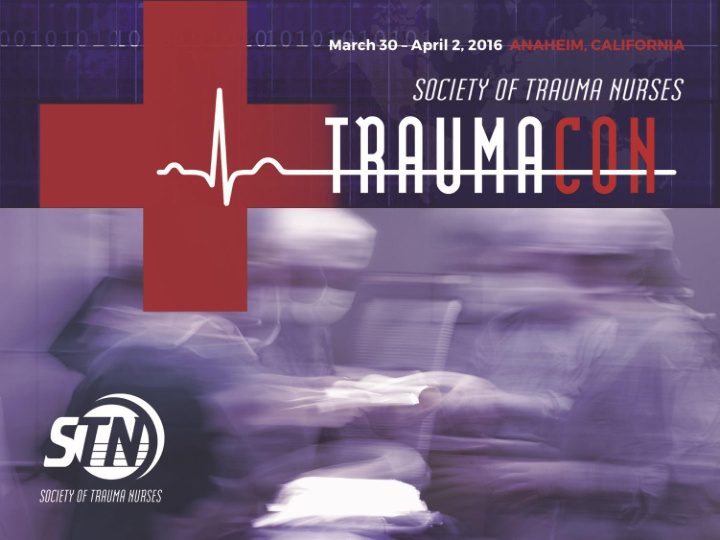



Ho How w to to Ap Apply Dat ply Data a to to Im Impact pact Ch Change ange Sarah Mattocks, RN, MSN, CRNP
Learning Objectives • Understand the audience to whom goals and objectives are being presented • Increase knowledge of using data to drive marketing, performance improvement and financial goals • Demonstrate utilization of data to tell a story
Disclosure Statement • I, Sarah Mattocks, have no conflict of interest relative to this educational activity to disclose.
Successful Completion • To successfully complete this course, participants must attend the entire event and complete/submit the evaluation at the end of the session. • Society of Trauma Nurses is accredited as a provider of continuing nursing education by the American Nurses Credentialing Center's Commission on Accreditation.
Data in Healthcare Today
• Big data - a broad term for data sets so large or complex that traditional data processing applications are inadequate
Putting Data to Work • Data and analytics have the ability to: • Helping us to become smarter • Improve patient care • Become more productive • Become better at making predictions • Tapping this potential for any organization begins with shaping a plan
Shaping the Plan
Your Role
From Data to Story • Define the audience • Create hypothesis • Sketch • Get data • Explore data • Tell the story
• https://www.youtube.com/watch?v=AL- PAzrpqUQ&feature=player_embedded
• Think of a current situation in your work that you would like to change • Ask yourself • What is the story? • Why am I doing this?
My Story In 2011, 53 exploratory laparotomy procedures done for trauma • The hypotensive subset median time from ED arrival to incision was 99 minutes • The normotensive subset median time from ED arrival to incision was 66 minutes
Defining Your Audience • Benefits of defining your audience • Identifying what motivates your listeners to act • Tailoring your content to give them specifically what they want, need and expect • Projecting an appropriate presentation style and personality • Increasing your comfort level as a speaker • Obtaining your objective for making the presentation
“By defining your audience members and tailoring your message to specifically address their reasons, wants and needs, you are able to deliver a presentation that engages, informs and persuades. Show them that you know them and they will gladly give you their time and attention – and most likely their business.” Excerpt from The Importance of Defining Your Audience By Darlene Price and John Messerschmitt
Create Hypothesis • Explain what you expect to happen • Be clear and understandable • Be testable • Be measurable • Contain independent and dependent variables
Hypothesis What do you want from your data? • To be successful, a project hypothesis should always include: • Context • What are you trying to achieve? • Who is invested in the project's results? • Are there any larger goals or deadlines that can help prioritize the project? • Need • Vision • Outcome
Getting the Data – The Need • What specific needs could be addressed by intelligently using data? • What can this project accomplish that was impossible before?
Sketch - Build a Framework • Sketch: Define your motivation/ inspiration • Prepare: Do your data homework • Visualize: Bring data to life
Outcome • How and by whom will the result be used and integrated into the company? • How will the success of the project be measured?
Explore the Data - Vision • What will meeting the need with data look like? • Is it possible to mock up the final result? • What is the logic behind the solution?
Telling the Story with Data • We are not naturally gifted at storytelling with data • Poorly prepared • Rely on tools
Quick Tips for Data Presentation • Understand the context • Choose an appropriate visual display • Eliminate clutter • Focus your attention where you want it • Think like a designer • Tell your story
Understanding the context • E xploratory vs. E xplanatory analysis • Choose appropriate and effective visuals • Simple text • Scatterplots • Line graph • Slope graphs • Bar graphs
Clutter…
Clearing the Clutter • Cognitive Load • Human brain has finite amount of mental processing power • Be smart about using audience’s brain power • Perceived cognitive load • How hard are they going to have to work to understand information you are presenting Less Le ss is m s mor ore e ~Mies es van n der r Roh ohe
Eliminate Distractions • Not all data are equally important • When detail isn’t needed, summarize • Ask yourself: would eliminating this change anything? • Push necessary, but non-message-impacting items to the background
Telling the Story • By highlighting the important stuff and eliminating distractions you markedly improved visual presentation…
Summary • Define the audience • Create hypothesis • Sketch • Get data • Explore data • Tell the story
References Kayyali, B., Knott, D., and Van Kuiken, S. (2013). The ‘big data’ revolution in US healthcare. Retrieved from http:// healthcare.mckinsey.com/big-data-revolution-us-healthcare Nussbaumer Knaflic, Cole. [2015]. Storytelling with Data: A Data Visualization Guide for Business Professionals. Hobocken, New Jersey: JOHN WILEY & SONS, INC. Price, D., and Messerschmitt, J. (2004). The Importance of Defining Your Audience. Retrieved from http://www.effectivemeetings.com/presenting/preparation/darlenejohn.asp Waisberg, D. (2014). From Data to Insights: The Blueprint for Your Business. Retrieved from https://www.thinkwithgoogle.com/articles/data-to-insights-blueprint-for-your- business.html Waisberg, D. (2014). Tell a Meaningful Story With Data. Retrieved from https://www.thinkwithgoogle.com/articles/tell-meaningful-stories-with-data.html Clip art and graphs: http://informationarts.pbworks.com/w/page/29374942/Taylor%20-%20Bad%20Graphs http://www.google.com/url?sa=i&rct=j&q=&esrc=s&source=images&cd=&cad=rja&uact=8&ved=0ahUKEwja7LSThPvKAhVDTCYKHS71AgwQjB0IBg&url=http%3A%2F%2Fwww.theusr us.de%2Fblog%2Fchildhood-faith-vs-current-faith%2F&psig=AFQjCNG6q5acxqJCQysMggbJx4uzqKremg&ust=1455669100016479
Recommend
More recommend